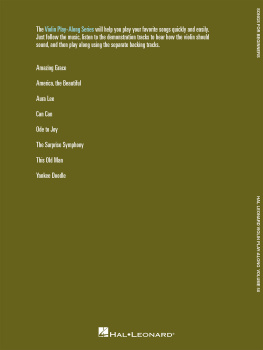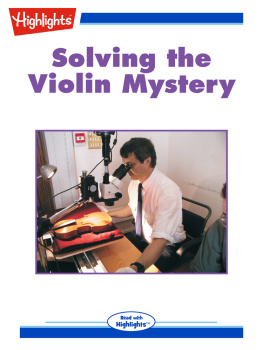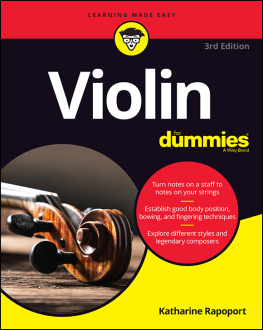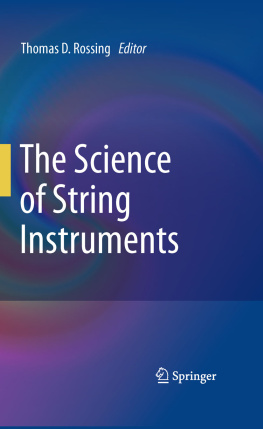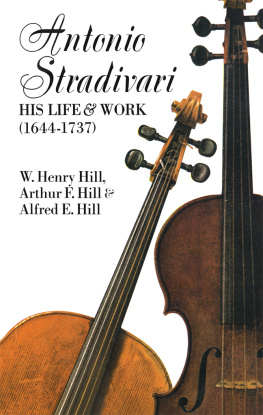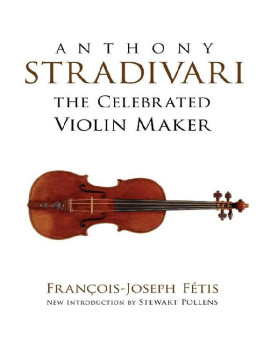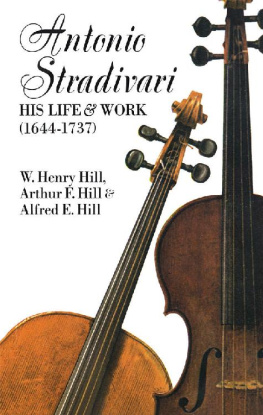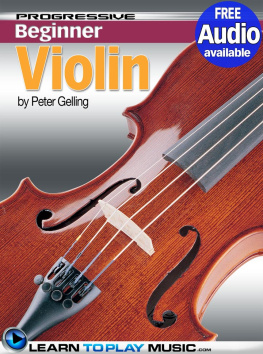The Violin Maker
A Search for the Secrets of Craftsmanship, Sound, and Stradivari
John Marchese

To four people who helped in so many ways
to make it possible for me to write any book, but who
didnt get to see this one:
John Marchese
Rosemary Marchese
Santino Marchese
Phyllis Marchese
Contents
The Magical Box
The Luthier
The Old Guy
The Violinist
The Singing Tree
Tradition and the Individual Talent
Bach and the Problem with Words
Caring More and More About Less and Less
What Do We Really Know?
We Go to Cremona
Varnishes and Very Curious Secrets
Delivery
What You Hear Under Your Ear
Coda

Based on a model of Antonio Stradivaris, circa 1715.
Drawing by Sam Zygmuntowicz.
F irst off, I have to thank Hana Smith for her contributions to this book.
The two men at the center of The Violin Maker , Sam Zygmuntowicz and Eugene Drucker, were in many ways collaborators as much as subjects. Sam graciously opened his workshop and spent many, many hours allowing me to look over his shoulder while he worked. I greatly appreciate the time he took to tutor me in the intricacies of his craft and his patience while trying to teach someone whose learning curve is often shaped more like a parabola.
Gene generously gave me opportunities to watch him make music and teach music and openly shared his thoughts and feelings. His musicianship is enlightening and inspiring. His literary skills will soon be on display with the publication of his first novel, The Savior .
In some way, both men inform nearly every page, though, of course, any mistakes or inaccuracies are mine alone.
Thanks to the nice folks who worked in the Brooklyn workshop: Wiltrud Fauler, Dietmar Schweizer, and Gladys Thomas Toscano.
My appreciation also to the other members of the great Emerson String QuartetPhil Setzer, Larry Dutton, and David Finckelwho were always friendly and helpful, and, along with their colleague, remarkable and inspiring musicians. Da-Hong Seetoo, their brilliant producer and engineer, was great fun to be with.
I owe a debt to the Violin Society of America and the people who run and participate in the annual workshops for violin makers and acousticians at Oberlin College. They are top craftsmen and researchers who are pushing the art of violin making forward in its fifth century. They willingly shared their knowledge, expertise, jokes, food, and booze. They include: Gregg Alf, Pam Anderson, Tom Croen, Joe Curtin, John Dilworth, Chis Dungey, David Folland, Chris Germain, Feng Jiang, Francis Morris, Frank Ravatin, Ben Ruth, Ray Schryer, Fan Tao, Marilyn Wallin, David Wiebe.
At HarperCollins, Marjorie Braman was the person who lit the spark for this book. When the resulting flame seemed like it might become eternal, she showed great patience. And when there was finally a manuscript, she deftly guided it with a sure hand and a light touch. Every writer should be so lucky.
Once again, my agent, David Black, came through in the clutch. If only the Jets would draft him.
Last and most, I have to thank Jana DeHart, my living companion, traveling companion, erstwhile research assistant, and irrepressible scout. She helped in so many ways that to say this book couldnt have been done without her would be a gross understatement.
THE MAGICAL BOX
T his story is about a craftsman entering the prime of his career who let me follow him as he tried to build a musical instrument that might top the work of the man who many think is the greatest craftsman who ever lived. His name was Antonio Stradivari, and he died more than 250 years ago.
Not long after I first met Sam Zygmuntowicz in Brooklyn, he invited me to join him in Ohio, where he was spending two weeks that summer teaching at a workshop of violin makers held at Oberlin University. The town of Oberlin is a quiet and neat place that seems to just pop out of cornfields about thirty-five miles southwest of Cleveland. The college dominates one side of the town with a mix of Gothic and modern buildings set on plush, trimmed lawns. There is a green and shady central square with clumps of tall trees that is dotted with monuments to fallen soldiers and murdered missionaries.
I drove to Oberlin in the first week of July, and the weather was shockingly hot and sticky. The shade of the square would have been a cool refuge at midday were it not for the fact that the college concurrently was hosting a festival of Scottish culture. Each day, bagpipers strolled on the thick grass under the tall trees, blew up their bellows, and emitted that ineffable sound that always makes me think a small farm animal is being slaughtered.
So, like me, most of the violin makers avoided the square at bagpipe time. It seemed a strange coincidence that aficionados of the worlds most annoying musical instrument would be in the same small midwestern town as two dozen people obsessed with the worlds most glorious musical tool. They didnt mingle. The bagpipe has its fans, of course. Tucked under the right armpit, the windbag can sound less than noxious. I have heard an African-American man in Philadelphia play good jazz on the thing. And on the green and shady lawn of a cemetery, pumping out Amazing Grace, the bagpipe can sound sublime.
In fact, I had been to a funeral not long before traveling to Oberlin, and that funeral, in a strange way, had helped bring me here. The former governor of Pennsylvania, Robert Casey, had died in his hometown of Scranton, and he was buried after a large and elaborate mass at the citys Catholic cathedral. I was hired to play trumpet in a brass quartet that supplemented the church organ on regal processional music and accompanied a large choir through serious liturgical hymns. The choir loft was packed with instrumentalists and singers added for this special service.
In the midst of the mass, after communion had been taken, a young man who sat near me stood among the gathered musicians and tucked a violin under his chin. He then played, accompanied by only a soft piano, the former governors favorite song. It was Irving Berlins How Deep Is the Ocean. Typical of Berlin, the song makes a lot out of little. The range is barely more than an octave. There are no long leaps between any two notes. The melody climbs through its range in a series of relaxed steps, like an old man on a staircase. It is a simple, pretty tune.
My guess is that the violinist may never have heard the seventy-year-old song before hed been asked to play it. He was only a teenager, just finishing high school and headed for a top music conservatorynot a prodigy, really, but a talent. That was evident from the first phrase of the song, as he dug his bow into the thick low string of the fiddle. The kid had a sound .
The church was packed with politicians, many of whom seemed more interested in being noticed than in mourning their dead colleague. But the moment that kid made his first notes on the fiddle, the crowd stilled and all the extraneous noise seem to rush from the church as from a vacuum. For the next few minutes, as the boy played Berlin, there was virtually no other sound in the large marbled vault. Even the accompanying piano seemed to disappear.
The violin in its low register sounded like a beautiful moan. On the second time through the chorus, the young man leaped to a higher octave and added more vibrato. The song became a sigh. The voice of the violin was singing without words. He climbed higher for the last notesin the lyrics a final question: How high is the sky? and it made the air in the church seem like crystal, like it could be shattered with a touch. When the violin stopped there was a long, long moment where it seemed the hundreds of listeners held their breath, lest they break the spell.
Next page

